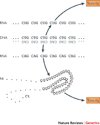Repeat expansion disease: progress and puzzles in disease pathogenesis
- PMID: 20177426
- PMCID: PMC4704680
- DOI: 10.1038/nrg2748
Repeat expansion disease: progress and puzzles in disease pathogenesis
Abstract
Repeat expansion mutations cause at least 22 inherited neurological diseases. The complexity of repeat disease genetics and pathobiology has revealed unexpected shared themes and mechanistic pathways among the diseases, such as RNA toxicity. Also, investigation of the polyglutamine diseases has identified post-translational modification as a key step in the pathogenic cascade and has shown that the autophagy pathway has an important role in the degradation of misfolded proteins--two themes that are likely to be relevant to the entire neurodegeneration field. Insights from repeat disease research are catalysing new lines of study that should not only elucidate molecular mechanisms of disease but also highlight opportunities for therapeutic intervention for these currently untreatable disorders.
Figures


Similar articles
-
Progress in pathogenesis studies of spinocerebellar ataxia type 1.Philos Trans R Soc Lond B Biol Sci. 1999 Jun 29;354(1386):1079-81. doi: 10.1098/rstb.1999.0462. Philos Trans R Soc Lond B Biol Sci. 1999. PMID: 10434309 Free PMC article. Review.
-
To be or not to be an aggregate.Clin Genet. 1999 Jan;55(1):9-10. doi: 10.1034/j.1399-0004.1999.550102.x. Clin Genet. 1999. PMID: 10066024 Review. No abstract available.
-
Anomalous rapid electrophoretic mobility of DNA containing triplet repeats associated with human disease genes.Biochemistry. 1995 Dec 12;34(49):16125-31. doi: 10.1021/bi00049a027. Biochemistry. 1995. PMID: 8519769
-
No association of the SCA1 (CAG)31 allele with Huntington's disease, myotonic dystrophy type 1 and spinocerebellar ataxia type 3.Psychiatr Genet. 2004 Jun;14(2):61-3. doi: 10.1097/01.ypg.0000128763.69225.77. Psychiatr Genet. 2004. PMID: 15167689
-
Pathogenic mechanisms of a polyglutamine-mediated neurodegenerative disease, spinocerebellar ataxia type 1.J Biol Chem. 2009 Mar 20;284(12):7425-9. doi: 10.1074/jbc.R800041200. Epub 2008 Oct 28. J Biol Chem. 2009. PMID: 18957430 Free PMC article. Review.
Cited by
-
Genetic testing: predictive value of genotyping for diagnosis and management of disease.EPMA J. 2011 Jun;2(2):173-9. doi: 10.1007/s13167-011-0077-y. Epub 2011 May 6. EPMA J. 2011. PMID: 23199147 Free PMC article.
-
siRNA Therapeutics: Future Promise for Neurodegenerative Diseases.Curr Neuropharmacol. 2021;19(11):1896-1911. doi: 10.2174/1570159X19666210402104054. Curr Neuropharmacol. 2021. PMID: 33797386 Free PMC article. Review.
-
Forensic Autosomal Short Tandem Repeats and Their Potential Association With Phenotype.Front Genet. 2020 Aug 6;11:884. doi: 10.3389/fgene.2020.00884. eCollection 2020. Front Genet. 2020. PMID: 32849844 Free PMC article. Review.
-
Twisting right to left: A…A mismatch in a CAG trinucleotide repeat overexpansion provokes left-handed Z-DNA conformation.PLoS Comput Biol. 2015 Apr 13;11(4):e1004162. doi: 10.1371/journal.pcbi.1004162. eCollection 2015 Apr. PLoS Comput Biol. 2015. PMID: 25876062 Free PMC article.
-
LUSTR: a new customizable tool for calling genome-wide germline and somatic short tandem repeat variants.BMC Genomics. 2024 Jan 26;25(1):115. doi: 10.1186/s12864-023-09935-9. BMC Genomics. 2024. PMID: 38279154 Free PMC article.
References
-
- La Spada AR, Wilson EM, Lubahn DB, Harding AE, Fischbeck KH. Androgen receptor gene mutations in X-linked spinal and bulbar muscular atrophy. Nature. 1991;352:77–79. - PubMed
-
- Verkerk AJ, et al. Identification of a gene (FMR-1) containing a CGG repeat coincident with a breakpoint cluster region exhibiting length variation in fragile X syndrome. Cell. 1991;65:905–914. - PubMed
-
- Ashley CT, et al. Human and murine FMR-1: alternative splicing and translational initiation downstream of the CGG-repeat. Nat Genet. 1993;4:244–251. - PubMed
-
- Bell MV, et al. Physical mapping across the fragile X: hypermethylation and clinical expression of the fragile X syndrome. Cell. 1991;64:861–866. - PubMed
-
- Heitz D, et al. Isolation of sequences that span the fragile X and identification of a fragile X-related CpG island. Science. 1991;251:1236–1239. - PubMed
Publication types
MeSH terms
Substances
Supplementary concepts
Grants and funding
LinkOut - more resources
Full Text Sources
Other Literature Sources
Medical

